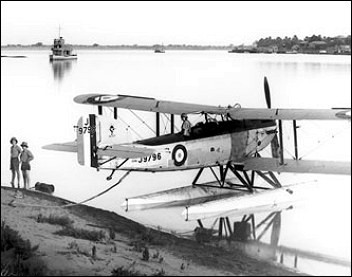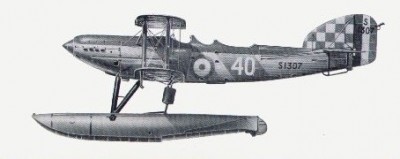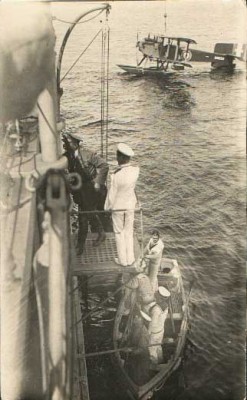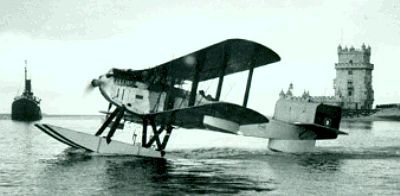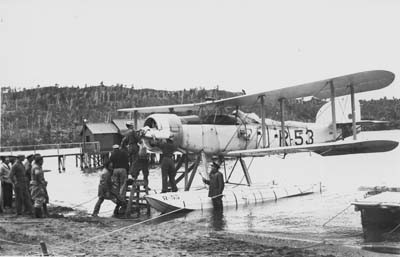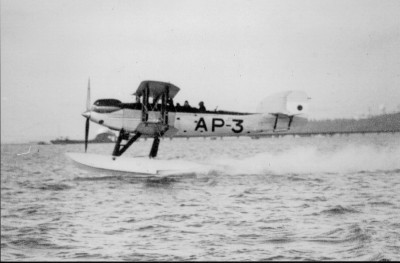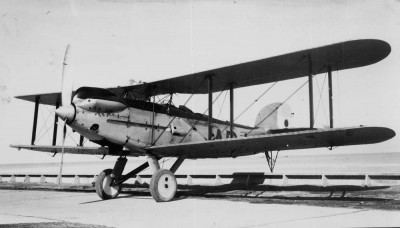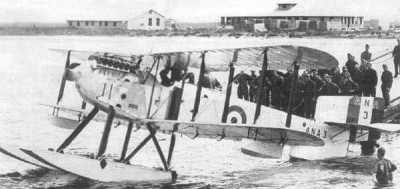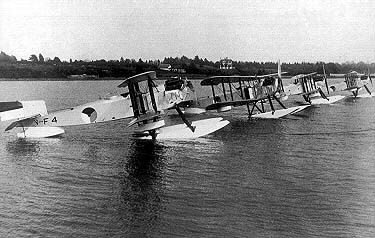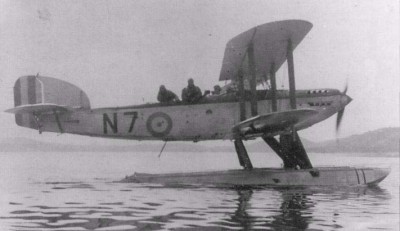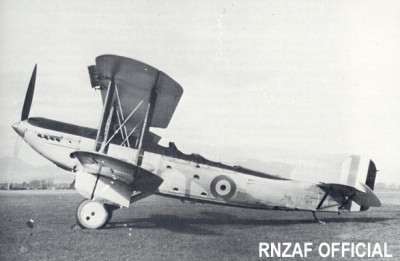Fairey III
Fairey III is the name of a family of British multi-purpose biplanes, which included seaplanes and ground machines. The predecessor of Fairey III was a seaplane N.10 (otherwise also F.128), built by Fairey Aviation for the Royal Naval Air Service and whose first flight took place on September 14, 1917.
The first series models were wheeled IIIA and float IIIB, of which 50 and 30 were produced. The onboard bomber Fairey IIIA was basically a wheeled version of N.10 and was intended as a replacement for the obsolete Sopwithy 1 1/2 Strutter. It was a two-truss biplane with the same wingspan. Before the end of the war, only one machine was delivered to RNAS, so it probably did not experience any deployment. They were powered by a Sunbeam Maori engine with an output of 194 kW. In service with two squadrons RNAS lasted until April 1919. Fairey IIIB responded to the requirements of N.2B differed in addition to the installation of floats also larger span of the upper wing and keel with the third float. Several planes were flown to Eastchurch and Felixstowe before the armistice, decommissioned in February 1920. The first flight of Fairey IIIA took place in June 1918, Fairey IIIB in August of that year.
The following multi-purpose variant IIIC got into the service of the Navy after the armistice, although one machine was delivered to the base in Great Yarmouth just before armistice. The wings of this version were identical to version A, but it had a float chassis version B and for the first time also a more powerful Rolls-Royce Eagle VIII engine with an output of 280 kW. A total of 35 machines were produced, of which about thirty were originally under construction or completed as version IIIB. These machines were deployed at home and overseas until the autumn of 1921. Several machines, perhaps seven, were used as bombers at the North Russian Expeditionary Force in Arkhangelsk and Murmansk in 1919. On June 8, 1919, IIICs were attacked without major effect by Bolshevik ships and later they attacked the railway.
The first production-significant model was Fairey IIID, which was created on the basis of specifications 38/22 and benefited from the considerable experience gained in the operation of Trojek at RFC and RNAS. The prototype, also known as IIIC (Improved), first took off in August 1920. It was a machine designed to operate on floats and wheels. The prototype was given to the Eagle VIII engine, but of the 207 machines built for the RAF and FAA, 152 received a twelve-cylinder, liquid-cooled Napier Lion IIB, V or VA engine with an output of 336 kW. He served not only at 202. Squadron RAF and on FAA ships of the domestic and Mediterranean fleets (one or two wheeled machines were also at most ground bases of the Navy), but also in Portugal and Australia, which received six IIID. Among other things, the Australian machines were powered similarly to the prototype Rolls-Royce Eagle VIII engines by 280 kW. By 1926, a total of 224 Fairey IIID were built, one of which was experimentally equipped with metal wings and floats. Machines from HMS Argus served in 1927 in the Shanghai Defense Forces, where they helped defend British interests from Chinese insurgents.
Fairey IIID was also used for one of the first RAF record flights, in formation from England to South Africa under the leadership of Wg Cdr CWH Pulforda. Between March 1 and June 21, 1926, four IIIDs flew almost 22,530 km on the Cairo-Cape Town-Cairo route and then to Lee-on-Solent, during which time there were no airframe or engine failures.
Fairey III seaplanes could be launched from an aircraft carrier's deck using a disposable cart, landed on water, or ejected from a ship.It was even the first FAA standard seaplane to be launched from a vessel at sea on 30 October 1925 using a catapult. The naval variant was usually three-seater (pilot, observer and shooter) and the wings could be tilted to the fuselage. However, several two-seater machines were also made, which were usually used as training machines, or for towing targets. In the ground variant, IIID was the first operationally deployed machine to have oil-pneumatic shock absorbers.
The most widespread was the last model, Fairey IIIF, which entered service with the RAF in Egypt in 1927 and the RNZAF shortly thereafter. IIIF was created mainly from the need to replace Eagle engines with more powerful Napiery Lion, it also had an all-metal fuselage and later all-metal wings and a metal propeller. The order was for a two-seater multi-purpose aircraft for the RAF and a three-seater aircraft for reconnaissance and fire guidance for the navy. The FAA served over 300 Fairey IIIF, making it the most numerous naval aircraft in the interwar period. In fact, more was produced between the wars only Hawker Hart. The IIIF remained in service in the 1930s, several machines were used to tow targets even in 1941. The N.198 prototype first flew in Northolt on April 19, 1926. Although it was very similar to the previous version, it underwent a thorough aerodynamic modification of the bow and cross section fuselage (with a structure of steel tubes) became instead of the original rectangle oval. It was also equipped with a metal propeller brand Fairey-Reed. The wings were wooden and did not differ from the wings of the previous version. The original rectangular rudder was replaced by a new, higher one. An oval signpost then appeared on later machines. In addition to the pilot, the crew of the FAA's three-seater aircraft also included a wireless radio operator/shooter and an observer.
Fairey IIIF aircraft were produced in four basic variants, but there were many subversions, differing in equipment and construction (mixed or all-metal). Two prototypes were followed by ten pre-series machines, one of these machines was tested as a two-seater multi-purpose and the last of them was used in 1927 for on-board tests at HMS Furious. The first serial version, Fairey IIIF Mk.I, had a mixed design and engine Lion version of the VA and existed in 40 pieces. Its prototype was flown to Northolt on February 18, 1927. On August 18, 1927, a prototype version of the Mk.II, equipped with the Lion XI engine, was flown there. 33 machines of this version also had a mixed design. As early as April 2, 1927, a prototype of Fairey III Mk.IIIM (M = Metal), originally the second prototype of IIIF, was released into the air. Serial production of this version, which had an all-metal construction and the Lion XIA engine, began in the spring of 1929 and a total of 103 machines were built. The last ten machines had dual control. This was followed by a modification of Mk.IIIB, which had several minor changes and had a reinforced hull for ejection . The first Fairey IIIF Mk.IIIB was flown on June 6, 1930. 166 machines of this subversion were built.
All machines supplied by the RAF (although some of them were originally for the FAA) bore the designation Fairey IIIF Mk.IV and were in fact introduced into service before the naval versions. The specifications of the Ministry of Aviation 19/24 required a multi-purpose ground aircraft to replace the obsolete RAF bases obsolete Bristol F.2B. The first versions of the RAF were the IIIF Mk.IVC (C = Composite), which had a metal butt and wooden wings, like the Mk.I, and the first unit to encircle them was a multi-purpose 47. Squadron in Khartoum. In 1929, she also received several float stands that flew from the Nile.The next series of 43 machines was marked as IIIF Mk.IVCM (standing J9132-9139) and Mk.IVM (J9140-9174) - first they had a metal hull structure, complete with wooden longitudinal beams, the other, except for the wooden ribs of the tail, an all-metal structure. Most of these machines were delivered in 1928 207. bomber squadrons in Eastchurch, where they were moved to supplement the status of some originally naval Mk.I.
From mid-1928 to 1930, the main variant of the RAF was Mk.IVM, in January 1930 supplemented by subvariant Mk.IVM/A, which already had a truly all-metal construction. The only other domestic rod with Faireya IIIF was 35. Squadron, which was restored in January 1929 in Bircham Newton. From November of the same year began to receive the first IIIF Mk.IVM. In addition to them, however, Fairey served throughout the Middle East and Africa, for example at 47. Squadron in Khartoum, 8. Squadron in Aden Chormanksar, 45. Squadrons in Helwan and Maltese Egyptian 202. squad. In 1930, the latest version of the RAF also appeared, Fairey IIIF Mk.IVB, which was built in 62 pieces. These were elometal machines that had a reinforced hull like a naval Mk.IIIB. However, some of the modifications of this car, such as points for hanging bomb hangers, also had some previous variants.
Most of the RAF's IIIF was delivered between 1927 and 1932. The machines, intended for overseas units, were transported to Abúkir, from where they continued. All major repairs were also carried out in Abukir, and many IIIFs were later rebuilt to Fairey Gordon.
Fairey IIIF entered service with the FAA in 1927 and replaced it in the 440th Squadron Fairey IIID. They also became the first machines of the 445 and 446 squadrons. Replacement continued in 1931 in the 449th and 450th Airmen, where Blackburny Blackburn and the 442nd and 443rd Airmen were shut down, where the last serving IIID. Finally, in November 1932, the IIIF entered the armament of the 460th Squadron instead of the Blackburn Rippon. In 1933, these squadrons merged into five observation squadrons, 820., 822., 823., 824. a 825.
Because the hooks were not used at this time, only one experimental machine received this device. He flew in 1931 on board HMS Courageous. Unlike previous versions, the IIIF already had modern metal floats without auxiliary floats at the wingtips and under the tail. Floats Mk.IIIB served on board warships, such as eight on HMS York and five more at HMS Exeter. The three IIIF machines were also converted to radio-controlled targets for shooting practice and were referred to as the Fairie Queen. These machines had a larger span and also an autopilot. One of them was stationed in Gibraltar for some time and was eventually shot in Malta. Based on Fairey IIIF, his successors were created Fairey Gordon (originally Fairey IIIF Mk.V) and Fairey Seal (Fairey IIIF Mk.VI). Of course, experiments with other motorization were also performed on Fairey III.The 474 kW Rolls-Royce Kestrel II, 391 kW Panther IIA, 388 kW Bristol Jupiter VIII, the same power Napier Culverin and even the Junkers Jumo V205C diesel engine were tested. All Fairey IIIFs were phased out in 1940.
The only surviving Fairey III out of a total of 486 machines produced is the "Santa Cruz", which is now housed in the Museu da Marinha in Lisbon, Portugal, where a replica is also on display in the Aviation Museum. The British Fleet Air Arm Museum has a fuselage.
Users (by version):
Fairey IIIA and IIIB - Royal Naval Air Service/Royal Air Force
Fairey IIIC - Royal Air Force
Fairey IIID - RAF, Royal Navy, Fleet Air Arm, Australia (6 machines), Netherlands (4), Portugal (11), Sweden (2)
Fairey IIIF - RAF, Royal Navy, FAA, Argentina (6), Chile (1), Greece (10), Ireland (3), New Zealand (3), Soviet Union (1)
Overview of versions and number of produced pieces:
(by www.britishaircraft.co.uk)
Source:
Mason, Francis K.:The Fairey IIIF, Profile No.44. Profile Publications, Leatherhead 1965
Thetford, Owen: British Naval Aircraft since 1912, Naval Institute Press, Annapolis 1991, ISBN 1-55750-076-2
http://avia.russian.ee/air/england/fairey_3.php
http://en.wikipedia.org/wiki/Fairey_III
http://en.wikipedia.org/wiki/MacRobertson_Air_Race
http://www.airwar.ru/enc/other1/fairey3.html
http://honeymooney.com/brazil/brazil_initial.htm
www.delscope.demon.co.uk
www.lietadla.com
http://lotnictwo.net/doc.php?doc=03122101
www.english-heritage.org.uk
www.fleetairarmarchive.net
www.britishaircraft.co.uk
www.rcaf.com
Fairey IIIF Mk.IVM, 47. peruť RAF.
Zdroj: http://avia.russian.ee/air/england/fairey_3.php
Bokorys Fairey IIIF Mk.IIIM, HMS Courageous, letka No.446 FAA. Zdroj:www.fleetairarmarchive.net
Fairey IIIC nasazený v roce 1919 v Rusku jako palubní letoun HMS Pegasus. Zdroj: www.earlyaviator.com
Fairey III is the name of a family of British multi-purpose biplanes, which included seaplanes and ground machines. The predecessor of Fairey III was a seaplane N.10 (otherwise also F.128), built by Fairey Aviation for the Royal Naval Air Service and whose first flight took place on September 14, 1917.
The first series models were wheeled IIIA and float IIIB, of which 50 and 30 were produced. The onboard bomber Fairey IIIA was basically a wheeled version of N.10 and was intended as a replacement for the obsolete Sopwithy 1 1/2 Strutter. It was a two-truss biplane with the same wingspan. Before the end of the war, only one machine was delivered to RNAS, so it probably did not experience any deployment. They were powered by a Sunbeam Maori engine with an output of 194 kW. In service with two squadrons RNAS lasted until April 1919. Fairey IIIB responded to the requirements of N.2B differed in addition to the installation of floats also larger span of the upper wing and keel with the third float. Several planes were flown to Eastchurch and Felixstowe before the armistice, decommissioned in February 1920. The first flight of Fairey IIIA took place in June 1918, Fairey IIIB in August of that year.
The following multi-purpose variant IIIC got into the service of the Navy after the armistice, although one machine was delivered to the base in Great Yarmouth just before armistice. The wings of this version were identical to version A, but it had a float chassis version B and for the first time also a more powerful Rolls-Royce Eagle VIII engine with an output of 280 kW. A total of 35 machines were produced, of which about thirty were originally under construction or completed as version IIIB. These machines were deployed at home and overseas until the autumn of 1921. Several machines, perhaps seven, were used as bombers at the North Russian Expeditionary Force in Arkhangelsk and Murmansk in 1919. On June 8, 1919, IIICs were attacked without major effect by Bolshevik ships and later they attacked the railway.
The first production-significant model was Fairey IIID, which was created on the basis of specifications 38/22 and benefited from the considerable experience gained in the operation of Trojek at RFC and RNAS. The prototype, also known as IIIC (Improved), first took off in August 1920. It was a machine designed to operate on floats and wheels. The prototype was given to the Eagle VIII engine, but of the 207 machines built for the RAF and FAA, 152 received a twelve-cylinder, liquid-cooled Napier Lion IIB, V or VA engine with an output of 336 kW. He served not only at 202. Squadron RAF and on FAA ships of the domestic and Mediterranean fleets (one or two wheeled machines were also at most ground bases of the Navy), but also in Portugal and Australia, which received six IIID. Among other things, the Australian machines were powered similarly to the prototype Rolls-Royce Eagle VIII engines by 280 kW. By 1926, a total of 224 Fairey IIID were built, one of which was experimentally equipped with metal wings and floats. Machines from HMS Argus served in 1927 in the Shanghai Defense Forces, where they helped defend British interests from Chinese insurgents.
Fairey IIID was also used for one of the first RAF record flights, in formation from England to South Africa under the leadership of Wg Cdr CWH Pulforda. Between March 1 and June 21, 1926, four IIIDs flew almost 22,530 km on the Cairo-Cape Town-Cairo route and then to Lee-on-Solent, during which time there were no airframe or engine failures.
Fairey III seaplanes could be launched from an aircraft carrier's deck using a disposable cart, landed on water, or ejected from a ship.It was even the first FAA standard seaplane to be launched from a vessel at sea on 30 October 1925 using a catapult. The naval variant was usually three-seater (pilot, observer and shooter) and the wings could be tilted to the fuselage. However, several two-seater machines were also made, which were usually used as training machines, or for towing targets. In the ground variant, IIID was the first operationally deployed machine to have oil-pneumatic shock absorbers.
The most widespread was the last model, Fairey IIIF, which entered service with the RAF in Egypt in 1927 and the RNZAF shortly thereafter. IIIF was created mainly from the need to replace Eagle engines with more powerful Napiery Lion, it also had an all-metal fuselage and later all-metal wings and a metal propeller. The order was for a two-seater multi-purpose aircraft for the RAF and a three-seater aircraft for reconnaissance and fire guidance for the navy. The FAA served over 300 Fairey IIIF, making it the most numerous naval aircraft in the interwar period. In fact, more was produced between the wars only Hawker Hart. The IIIF remained in service in the 1930s, several machines were used to tow targets even in 1941. The N.198 prototype first flew in Northolt on April 19, 1926. Although it was very similar to the previous version, it underwent a thorough aerodynamic modification of the bow and cross section fuselage (with a structure of steel tubes) became instead of the original rectangle oval. It was also equipped with a metal propeller brand Fairey-Reed. The wings were wooden and did not differ from the wings of the previous version. The original rectangular rudder was replaced by a new, higher one. An oval signpost then appeared on later machines. In addition to the pilot, the crew of the FAA's three-seater aircraft also included a wireless radio operator/shooter and an observer.
Fairey IIIF aircraft were produced in four basic variants, but there were many subversions, differing in equipment and construction (mixed or all-metal). Two prototypes were followed by ten pre-series machines, one of these machines was tested as a two-seater multi-purpose and the last of them was used in 1927 for on-board tests at HMS Furious. The first serial version, Fairey IIIF Mk.I, had a mixed design and engine Lion version of the VA and existed in 40 pieces. Its prototype was flown to Northolt on February 18, 1927. On August 18, 1927, a prototype version of the Mk.II, equipped with the Lion XI engine, was flown there. 33 machines of this version also had a mixed design. As early as April 2, 1927, a prototype of Fairey III Mk.IIIM (M = Metal), originally the second prototype of IIIF, was released into the air. Serial production of this version, which had an all-metal construction and the Lion XIA engine, began in the spring of 1929 and a total of 103 machines were built. The last ten machines had dual control. This was followed by a modification of Mk.IIIB, which had several minor changes and had a reinforced hull for ejection . The first Fairey IIIF Mk.IIIB was flown on June 6, 1930. 166 machines of this subversion were built.
All machines supplied by the RAF (although some of them were originally for the FAA) bore the designation Fairey IIIF Mk.IV and were in fact introduced into service before the naval versions. The specifications of the Ministry of Aviation 19/24 required a multi-purpose ground aircraft to replace the obsolete RAF bases obsolete Bristol F.2B. The first versions of the RAF were the IIIF Mk.IVC (C = Composite), which had a metal butt and wooden wings, like the Mk.I, and the first unit to encircle them was a multi-purpose 47. Squadron in Khartoum. In 1929, she also received several float stands that flew from the Nile.The next series of 43 machines was marked as IIIF Mk.IVCM (standing J9132-9139) and Mk.IVM (J9140-9174) - first they had a metal hull structure, complete with wooden longitudinal beams, the other, except for the wooden ribs of the tail, an all-metal structure. Most of these machines were delivered in 1928 207. bomber squadrons in Eastchurch, where they were moved to supplement the status of some originally naval Mk.I.
From mid-1928 to 1930, the main variant of the RAF was Mk.IVM, in January 1930 supplemented by subvariant Mk.IVM/A, which already had a truly all-metal construction. The only other domestic rod with Faireya IIIF was 35. Squadron, which was restored in January 1929 in Bircham Newton. From November of the same year began to receive the first IIIF Mk.IVM. In addition to them, however, Fairey served throughout the Middle East and Africa, for example at 47. Squadron in Khartoum, 8. Squadron in Aden Chormanksar, 45. Squadrons in Helwan and Maltese Egyptian 202. squad. In 1930, the latest version of the RAF also appeared, Fairey IIIF Mk.IVB, which was built in 62 pieces. These were elometal machines that had a reinforced hull like a naval Mk.IIIB. However, some of the modifications of this car, such as points for hanging bomb hangers, also had some previous variants.
Most of the RAF's IIIF was delivered between 1927 and 1932. The machines, intended for overseas units, were transported to Abúkir, from where they continued. All major repairs were also carried out in Abukir, and many IIIFs were later rebuilt to Fairey Gordon.
Fairey IIIF entered service with the FAA in 1927 and replaced it in the 440th Squadron Fairey IIID. They also became the first machines of the 445 and 446 squadrons. Replacement continued in 1931 in the 449th and 450th Airmen, where Blackburny Blackburn and the 442nd and 443rd Airmen were shut down, where the last serving IIID. Finally, in November 1932, the IIIF entered the armament of the 460th Squadron instead of the Blackburn Rippon. In 1933, these squadrons merged into five observation squadrons, 820., 822., 823., 824. a 825.
Because the hooks were not used at this time, only one experimental machine received this device. He flew in 1931 on board HMS Courageous. Unlike previous versions, the IIIF already had modern metal floats without auxiliary floats at the wingtips and under the tail. Floats Mk.IIIB served on board warships, such as eight on HMS York and five more at HMS Exeter. The three IIIF machines were also converted to radio-controlled targets for shooting practice and were referred to as the Fairie Queen. These machines had a larger span and also an autopilot. One of them was stationed in Gibraltar for some time and was eventually shot in Malta. Based on Fairey IIIF, his successors were created Fairey Gordon (originally Fairey IIIF Mk.V) and Fairey Seal (Fairey IIIF Mk.VI). Of course, experiments with other motorization were also performed on Fairey III.The 474 kW Rolls-Royce Kestrel II, 391 kW Panther IIA, 388 kW Bristol Jupiter VIII, the same power Napier Culverin and even the Junkers Jumo V205C diesel engine were tested. All Fairey IIIFs were phased out in 1940.
The only surviving Fairey III out of a total of 486 machines produced is the "Santa Cruz", which is now housed in the Museu da Marinha in Lisbon, Portugal, where a replica is also on display in the Aviation Museum. The British Fleet Air Arm Museum has a fuselage.
Users (by version):
Fairey IIIA and IIIB - Royal Naval Air Service/Royal Air Force
Fairey IIIC - Royal Air Force
Fairey IIID - RAF, Royal Navy, Fleet Air Arm, Australia (6 machines), Netherlands (4), Portugal (11), Sweden (2)
Fairey IIIF - RAF, Royal Navy, FAA, Argentina (6), Chile (1), Greece (10), Ireland (3), New Zealand (3), Soviet Union (1)
Overview of versions and number of produced pieces:
(by www.britishaircraft.co.uk)
| Version | Made by: Including conversions) |
| Fairey N.10 | 1 |
| Fairey IIIA | 50 |
| Fairey IIIB | 30 |
| Fairey IIIC | 35 |
| Fairey IIID | 224 |
| Fairey IIIF I | 55 |
| Fairey IIIF II | 33 |
| Fairey IIIF III (B, M) | 291 |
| Fairey IIIF IV (B, ...) | 243 |
Source:
Mason, Francis K.:The Fairey IIIF, Profile No.44. Profile Publications, Leatherhead 1965
Thetford, Owen: British Naval Aircraft since 1912, Naval Institute Press, Annapolis 1991, ISBN 1-55750-076-2
http://avia.russian.ee/air/england/fairey_3.php
http://en.wikipedia.org/wiki/Fairey_III
http://en.wikipedia.org/wiki/MacRobertson_Air_Race
http://www.airwar.ru/enc/other1/fairey3.html
http://honeymooney.com/brazil/brazil_initial.htm
www.delscope.demon.co.uk
www.lietadla.com
http://lotnictwo.net/doc.php?doc=03122101
www.english-heritage.org.uk
www.fleetairarmarchive.net
www.britishaircraft.co.uk
www.rcaf.com
| Period | - |
| Producer | - |
| Type | - |
| Camouflage | - |
| Country | - |
| Pilot | - |
| Production No. | - |
| Serial No. / Evidence No. | - |
| Tactical Marking / Imatriculation | - |
| Name | - |
| Unit | - |
| Base | - |
| Date (DD.MM.RRRR) | DD.MM.RRRR |
| Author | - |
| Print size / 300 DPI | - |
| Published with authors permit | - |
| Author Website | - |
Fairey IIIF Mk.IVM, 47. peruť RAF.
Zdroj: http://avia.russian.ee/air/england/fairey_3.php
| Period | - |
| Producer | - |
| Type | - |
| Camouflage | - |
| Country | - |
| Pilot | - |
| Production No. | - |
| Serial No. / Evidence No. | - |
| Tactical Marking / Imatriculation | - |
| Name | - |
| Unit | - |
| Base | - |
| Date (DD.MM.RRRR) | DD.MM.RRRR |
| Author | - |
| Print size / 300 DPI | - |
| Published with authors permit | - |
| Author Website | - |
Bokorys Fairey IIIF Mk.IIIM, HMS Courageous, letka No.446 FAA. Zdroj:www.fleetairarmarchive.net
| Period | - |
| Producer | - |
| Type | - |
| Camouflage | - |
| Country | - |
| Pilot | - |
| Production No. | - |
| Serial No. / Evidence No. | - |
| Tactical Marking / Imatriculation | - |
| Name | - |
| Unit | - |
| Base | - |
| Date (DD.MM.RRRR) | DD.MM.RRRR |
| Author | - |
| Print size / 300 DPI | - |
| Published with authors permit | - |
| Author Website | - |
Fairey IIIC nasazený v roce 1919 v Rusku jako palubní letoun HMS Pegasus. Zdroj: www.earlyaviator.com
